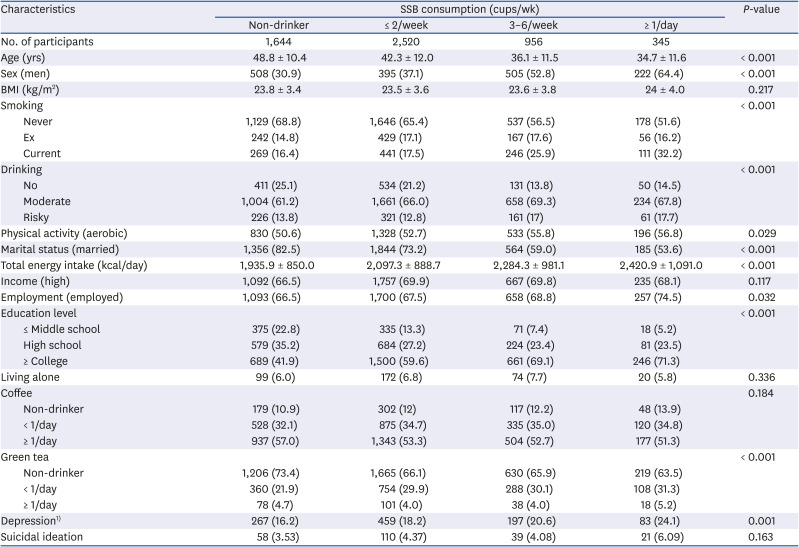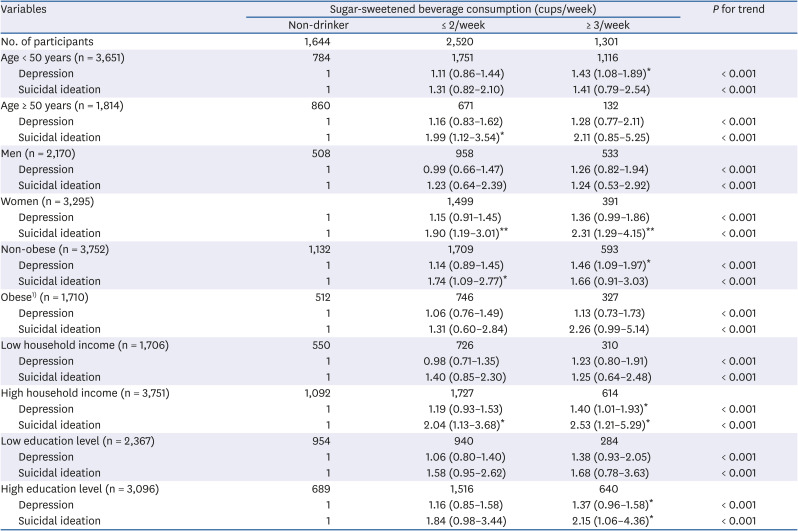1. Wada T, Ishine M, Sakagami T, Kita T, Okumiya K, Mizuno K, Rambo TA, Matsubayashi K. Depression, activities of daily living, and quality of life of community-dwelling elderly in three Asian countries: Indonesia, Vietnam, and Japan. Arch Gerontol Geriatr. 2005; 41:271–280. PMID:
15979739.
2. Liu Q, He H, Yang J, Feng X, Zhao F, Lyu J. Changes in the global burden of depression from 1990 to 2017: findings from the Global Burden of Disease study. J Psychiatr Res. 2020; 126:134–140. PMID:
31439359.
3. Sanchez-Villegas A, Martínez-González MA. Diet, a new target to prevent depression? BMC Med. 2013; 11:3. PMID:
23286788.
4. Hong JW, Noh JH, Kim DJ. The prevalence of and factors associated with depressive symptoms in the Korean adults: the 2014 and 2016 Korea National Health and Nutrition Examination Survey. Soc Psychiatry Psychiatr Epidemiol. 2021; 56:659–670. PMID:
32780175.
5. Malik VS, Popkin BM, Bray GA, Després JP, Willett WC, Hu FB. Sugar-sweetened beverages and risk of metabolic syndrome and type 2 diabetes: a meta-analysis. Diabetes Care. 2010; 33:2477–2483. PMID:
20693348.
6. Xi B, Huang Y, Reilly KH, Li S, Zheng R, Barrio-Lopez MT, Martinez-Gonzalez MA, Zhou D. Sugar-sweetened beverages and risk of hypertension and CVD: a dose-response meta-analysis. Br J Nutr. 2015; 113:709–717. PMID:
25735740.
7. Shi Z, Taylor AW, Wittert G, Goldney R, Gill TK. Soft drink consumption and mental health problems among adults in Australia. Public Health Nutr. 2010; 13:1073–1079. PMID:
20074392.
8. Kashino I, Kochi T, Imamura F, Eguchi M, Kuwahara K, Nanri A, Kurotani K, Akter S, Hu H, Miki T, et al. Prospective association of soft drink consumption with depressive symptoms. Nutrition. 2021; 81:110860. PMID:
32791444.
9. Yu B, He H, Zhang Q, Wu H, Du H, Liu L, Wang C, Shi H, Xia Y, Guo X, et al. Soft drink consumption is associated with depressive symptoms among adults in China. J Affect Disord. 2015; 172:422–427. PMID:
25451447.
10. Lim H, Lee HJ, Choue R, Wang Y. Trends in Fast-Food and Sugar-Sweetened Beverage Consumption and Their Association with Social Environmental Status in South Korea. J Acad Nutr Diet. 2018; 118:1228–1236.e1. PMID:
28988839.
11. Shim JS, Kang NH, Lee JS, Kim KN, Chung HK, Chung HR, Kim HJ, Ahn YS, Chang MJ. Socioeconomic burden of sugar-sweetened beverages consumption in Korea. Nutr Res Pract. 2019; 13:134–140. PMID:
30984357.
12. Hu D, Cheng L, Jiang W. Sugar-sweetened beverages consumption and the risk of depression: a meta-analysis of observational studies. J Affect Disord. 2019; 245:348–355. PMID:
30419536.
13. Hong SA, Peltzer K. Dietary behaviour, psychological well-being and mental distress among adolescents in Korea. Child Adolesc Psychiatry Ment Health. 2017; 11:56. PMID:
29209411.
14. Park S, Lee Y, Lee JH. Association between energy drink intake, sleep, stress, and suicidality in Korean adolescents: energy drink use in isolation or in combination with junk food consumption. Nutr J. 2016; 15:87. PMID:
27737671.
15. Kweon S, Kim Y, Jang MJ, Kim Y, Kim K, Choi S, Chun C, Khang YH, Oh K. Data resource profile: the Korea National Health and Nutrition Examination Survey (KNHANES). Int J Epidemiol. 2014; 43:69–77. PMID:
24585853.
16. Martin A, Rief W, Klaiberg A, Braehler E. Validity of the brief patient health questionnaire mood scale (PHQ-9) in the general population. Gen Hosp Psychiatry. 2006; 28:71–77. PMID:
16377369.
17. Han C, Jo SA, Kwak JH, Pae CU, Steffens D, Jo I, Park MH. Validation of the Patient Health Questionnaire-9 Korean version in the elderly population: the Ansan Geriatric study. Compr Psychiatry. 2008; 49:218–223. PMID:
18243897.
18. Shin S, Kim SA, Ha J, Lim K. Sugar-sweetened beverage consumption in relation to obesity and metabolic syndrome among Korean adults: a cross-sectional study from the 2012–2016 Korean National Health and Nutrition Examination Survey (KNHANES). Nutrients. 2018; 10:1467.
19. World Health Organization. International Guide for Monitoring Alcohol Consumption and Related Harm. Geneva: World Health Organization;2000.
20. Ministry of Health and Welfare. Guidelines for Physical Activity for Koreans. Sejong: Ministry of Health and Welfare;2013.
21. Guo X, Park Y, Freedman ND, Sinha R, Hollenbeck AR, Blair A, Chen H. Sweetened beverages, coffee, and tea and depression risk among older US adults. PLoS One. 2014; 9:e94715. PMID:
24743309.
22. Werneck AO, Schuch FB, Stubbs B, Oyeyemi AL, Szwarcwald CL, Vancampfort D, Silva DR. Independent and combined associations of sugar-sweetened beverage consumption, TV viewing, and physical activity with severe depressive symptoms among 59,402 adults. Braz J Psychiatry. Forthcoming. 2020.
23. DiNicolantonio JJ, Mehta V, Onkaramurthy N, O’Keefe JH. Fructose-induced inflammation and increased cortisol: a new mechanism for how sugar induces visceral adiposity. Prog Cardiovasc Dis. 2018; 61:3–9. PMID:
29225114.
24. Asarnow LD. Depression and sleep: what has the treatment research revealed and could the HPA axis be a potential mechanism? Curr Opin Psychol. 2020; 34:112–116. PMID:
31962280.
25. Lopez-Duran NL, Kovacs M, George CJ. Hypothalamic-pituitary-adrenal axis dysregulation in depressed children and adolescents: a meta-analysis. Psychoneuroendocrinology. 2009; 34:1272–1283. PMID:
19406581.
26. Esposito K, Nappo F, Marfella R, Giugliano G, Giugliano F, Ciotola M, Quagliaro L, Ceriello A, Giugliano D. Inflammatory cytokine concentrations are acutely increased by hyperglycemia in humans: role of oxidative stress. Circulation. 2002; 106:2067–2072. PMID:
12379575.
27. Valkanova V, Ebmeier KP, Allan CL. CRP, IL-6 and depression: a systematic review and meta-analysis of longitudinal studies. J Affect Disord. 2013; 150:736–744. PMID:
23870425.
28. Koopman KE, Booij J, Fliers E, Serlie MJ, la Fleur SE. Diet-induced changes in the Lean Brain: Hypercaloric high-fat-high-sugar snacking decreases serotonin transporters in the human hypothalamic region. Mol Metab. 2013; 2:417–422. PMID:
24327957.
29. Inam QU, Jabeen B, Haleem MA, Haleem DJ. Long-term consumption of sugar-rich diet decreases the effectiveness of somatodendritic serotonin-1A receptors. Nutr Neurosci. 2008; 11:277–282. PMID:
19000381.
30. Avena NM, Rada P, Hoebel BG. Evidence for sugar addiction: behavioral and neurochemical effects of intermittent, excessive sugar intake. Neurosci Biobehav Rev. 2008; 32:20–39. PMID:
17617461.
31. Imperatori C, Fabbricatore M, Innamorati M, Farina B, Quintiliani MI, Lamis DA, Mazzucchi E, Contardi A, Vollono C, Della Marca G. Modification of EEG functional connectivity and EEG power spectra in overweight and obese patients with food addiction: an eLORETA study. Brain Imaging Behav. 2015; 9:703–716. PMID:
25332109.
32. Schulte EM, Avena NM, Gearhardt AN. Which foods may be addictive? The roles of processing, fat content, and glycemic load. PLoS One. 2015; 10:e0117959. PMID:
25692302.









 PDF
PDF Citation
Citation Print
Print



 XML Download
XML Download